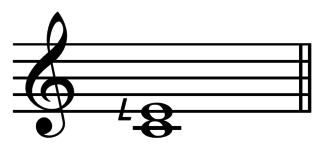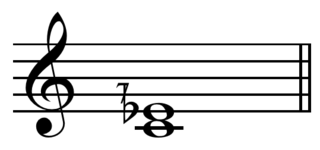 W
WIn classical music from Western culture, an augmented third is an interval of five semitones. It may be produced by widening a major third by a chromatic semitone. For instance, the interval from C to E is a major third, four semitones wide, and both the intervals from C♭ to E, and from C to E♯ are augmented thirds, spanning five semitones. Being augmented, it is considered a dissonant interval.
 W
WIn classical music from Western culture, a diminished third is the musical interval produced by narrowing a minor third by a chromatic semitone. For instance, the interval from A to C is a minor third, three semitones wide, and both the intervals from A♯ to C, and from A to C♭ are diminished thirds, two semitones wide. Being diminished, it is considered a dissonant interval.
 W
WIn music, a ditone is the interval of a major third. The size of a ditone varies according to the sizes of the two tones of which it is compounded. The largest is the Pythagorean ditone, with a ratio of 81:64, also called a comma-redundant major third; the smallest is the interval with a ratio of 100:81, also called a comma-deficient major third.
 W
WIn classical music, a third is a musical interval encompassing three staff positions, and the major third is a third spanning four semitones. Along with the minor third, the major third is one of two commonly occurring thirds. It is qualified as major because it is the larger of the two: the major third spans four semitones, the minor third three. For example, the interval from C to E is a major third, as the note E lies four semitones above C, and there are three staff positions from C to E. Diminished and augmented thirds span the same number of staff positions, but consist of a different number of semitones.The intervals from the tonic (keynote) in an upward direction to the second, to the third, to the sixth, and to the seventh scale degrees of a major scale are called major.
 W
WIn music theory a minor third is a musical interval that encompasses three half steps, or semitones. Staff notation represents the minor third as encompassing three staff positions. The minor third is one of two commonly occurring thirds. It is called minor because it is the smaller of the two: the major third spans an additional semitone. For example, the interval from A to C is a minor third, as the note C lies three semitones above A. Coincidentally, there are three staff positions from A to C. Diminished and augmented thirds span the same number of staff positions, but consist of a different number of semitones. The minor third is a skip melodically.
 W
WA neutral third is a musical interval wider than a minor third play (help·info) but narrower than a major third play (help·info), named by Jan Pieter Land in 1880. Land makes reference to the neutral third attributed to Zalzal, described by Al-Farabi as corresponding to a ratio of 27:22 and by Avicenna as 39:32. The Zalzalian third may have been a mobile interval.
 W
WIn music, the septimal major third play (help·info), also called the supermajor third and sometimes Bohlen–Pierce third is the musical interval exactly or approximately equal to a just 9:7 ratio of frequencies, or alternately 14:11. It is equal to 435 cents, sharper than a just major third (5:4) by the septimal quarter tone (36:35). In 24-TET the septimal major third is approximated by 9 quarter tones, or 450 cents. Both 24 and 19 equal temperament map the septimal major third and the septimal narrow fourth (21:16) to the same interval.
 W
WIn music, the septimal minor third play (help·info), also called the subminor third, is the musical interval exactly or approximately equal to a 7/6 ratio of frequencies. In terms of cents, it is 267 cents, a quartertone of size 36/35 flatter than a just minor third of 6/5. In 24-tone equal temperament five quarter tones approximate the septimal minor third at 250 cents. A septimal minor third is almost exactly two-ninths of an octave, and thus all divisions of the octave into multiples of nine have an almost perfect match to this interval. The septimal major sixth, 12/7, is the inverse of this interval.
 W
WIn music theory, tertian describes any piece, chord, counterpoint etc. constructed from the intervals of thirds. An interval such as that between the notes A and C encompasses 3 semitone intervals and is termed a minor third while one such as that between C and E encompasses 4 semitones and is called a major third. Tertian harmony principally uses chords based on thirds; the term is typically used to contrast with quartal and quintal harmony which uses chords based on fourths or fifths.